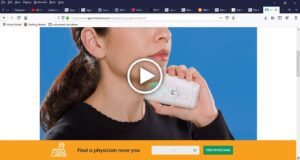Effects of Noninvasive Vagus Nerve Stimulation on Fatigue and Immune Response in Patients With Primary Sjogren’s Symdrome
Kristen Sparrow • October 24, 2019

 Photo is a representation of what the device looks like. (No video, just photo.)
Photo is a representation of what the device looks like. (No video, just photo.)
This article does not include HRV as a biomarker, but I’m interested in immune function and acupuncture/TAVNS, so though I’d link to this. I also try to keep track of proprietary devices for TVNS, (transcutaneous vagal nerve stimultioan).
The Effects of Noninvasive Vagus Nerve Stimulation on Fatigue and Immune Responses in Patients With Primary Sjögren’s Syndrome.
Author information
- 1
- Institute of Cellular Medicine, Newcastle University, Newcastle upon Tyne, UK.
- 2
- electroCore, Inc Basking Ridge, NJ, USA.
Abstract
OBJECTIVES:
Primary Sjögren’s syndrome (pSS) sufferers have rated chronic fatigue as the most important symptom needing improvement. Emerging data suggest that stimulation of the vagus nerve can modulate immunological responses. The gammaCore device (electroCore), developed to stimulate the cervical vagus nerve noninvasively, was used to assess the effects of vagus nerve activation on immune responses and clinical symptoms of pSS.
MATERIALS AND METHODS:
Fifteen female pSS subjects used the nVNS device twice daily a 26-day period. At baseline, blood was drawn before and after application of the gammaCore device for 90 sec over each carotid artery. The following fatigue-related outcome measures were collected at baseline, day 7 and day 28: EULAR patient reported outcome index, profile of fatigue (Pro-F), visual analogue scale of abnormal fatigue, and Epworth sleepiness scale (ESS). Whole blood samples were stimulated with 2 ng/mL lipopolysaccharide (LPS) and the supernatant levels of IFNγ, IL12-p70, TNFα, MIP-1α, IFNα, IL-10, IL-1β, IL-6, and IP-10 were measured at 24 hours. In addition, clinical hematology and flow cytometric profiles of whole blood immune cells were analyzed.
RESULTS:
Pro-F(profile of fatigue) and ESS (Epworth sleepiness scale) scores were significantly reduced across all three visits. Lipopolysaccharide LPS-stimulated production of IL-6, IL-1β, IP-10, MIP-1α, and TNFα were significantly reduced over the study period. Patterns of NK- and T-cell subsets also altered significantly over the study period. Interestingly, lymphocyte counts at baseline visit correlated to the reduction in fatigue score.
CONCLUSION:
The vagus nerve may play a role in the regulation of fatigue and immune responses in pSS and nVNS may reduce clinical symptoms of fatigue and sleepiness. However, a sham-controlled follow-up study with a larger sample size is required to confirm the findings.

